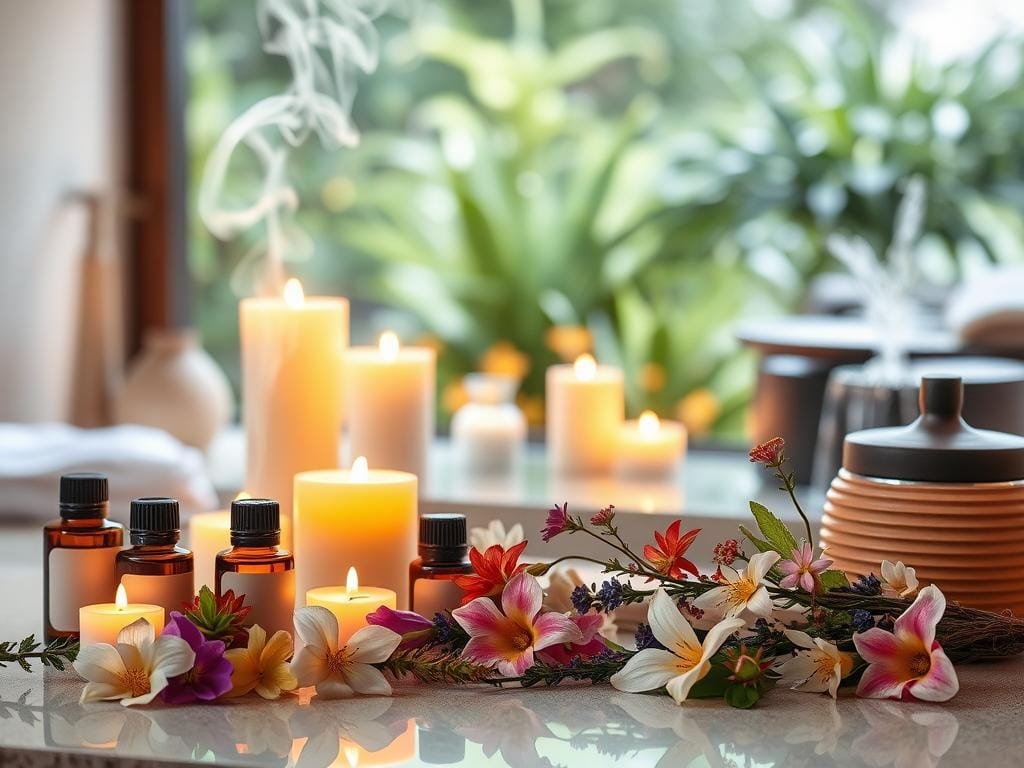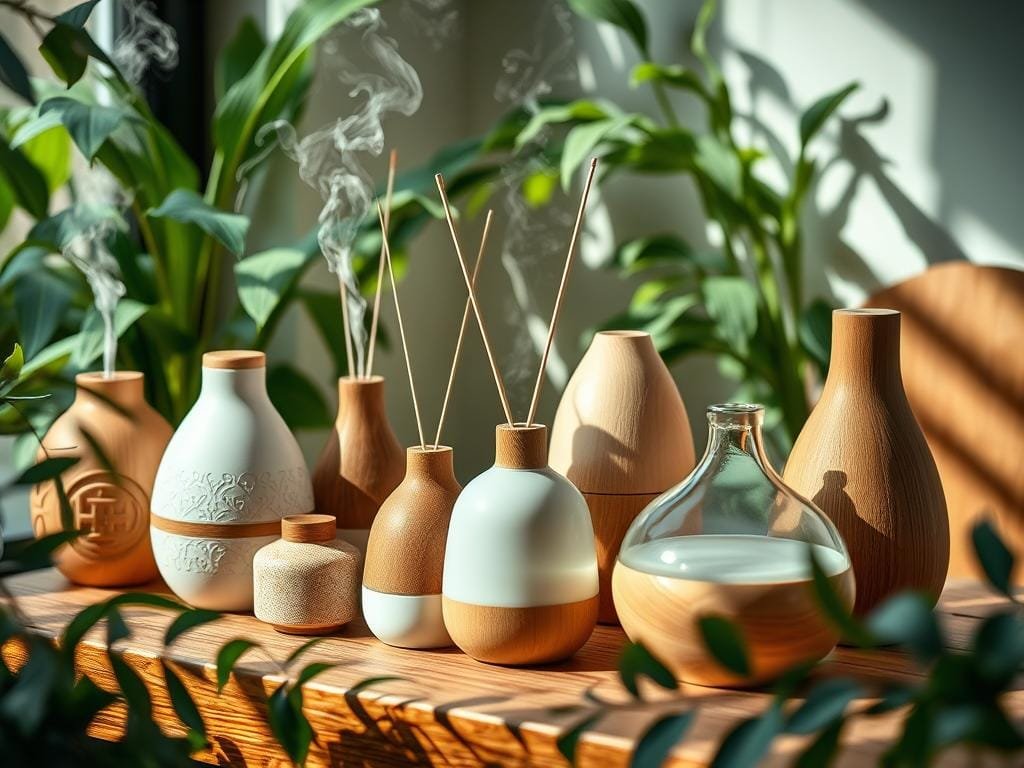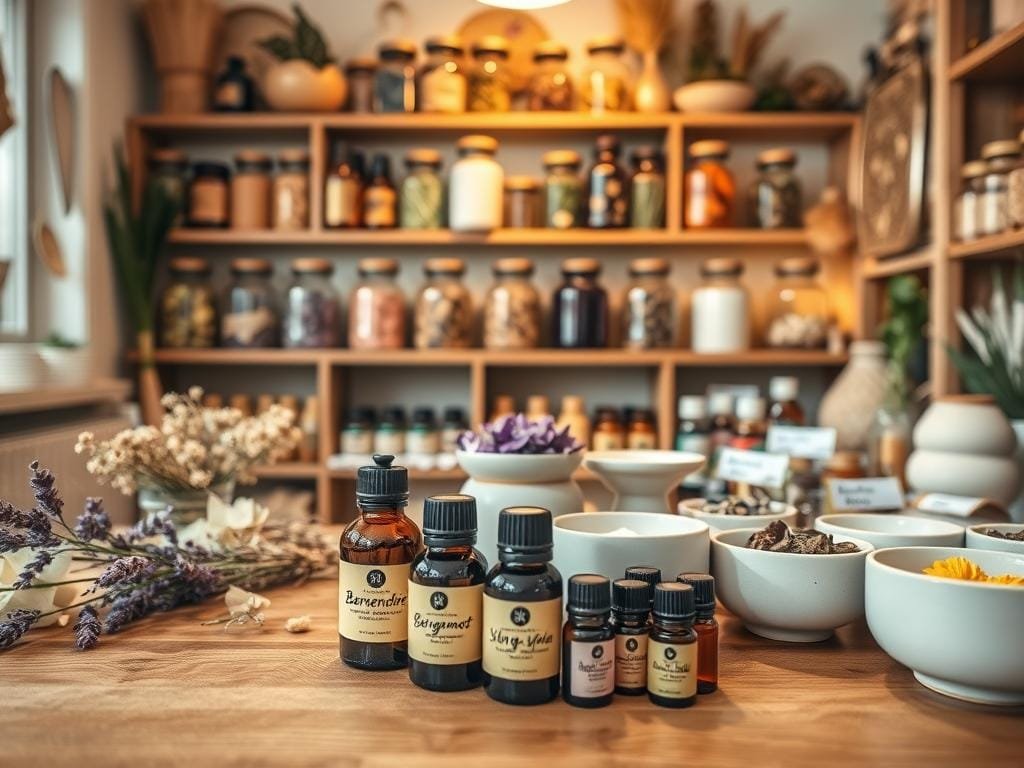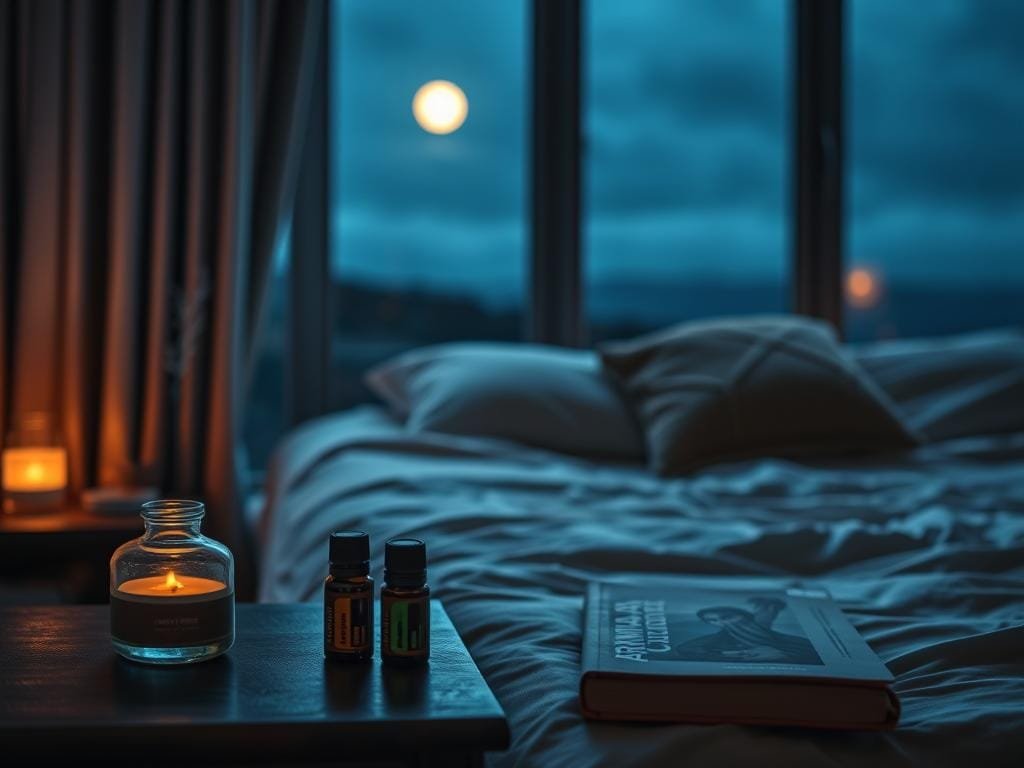Have you heard about essential oils? Many people around the world use aromatherapy to feel better. Research shows that certain smells can really change how we feel, from our mood to our stress levels.
Starting with essential oils might seem hard, but it’s easier than you think. Learning how to use these powerful plant extracts can boost your mood and health. Using essential oils can help with anxiety and even help you sleep better.
Table of Contents
Key Takeaways
- Discover the basics of aromatherapy and its benefits for mood and well-being.
- Learn about the most effective essential oils for beginners.
- Understand how to safely use essential oils for therapeutic benefits.
- Explore the different methods of aromatherapy for stress relief and relaxation.
- Find out how essential oils can improve sleep quality and duration.
What is Aromatherapy?
Aromatherapy uses essential oils to help with physical, emotional, and mental health. It has been around for centuries, starting with ancient civilizations.
Definition and Overview
Aromatherapy uses essential oils from plants to affect the brain’s limbic system. This system is tied to emotions and memory. So, aromatherapy is great for managing stress and anxiety.
People inhale these oils, either directly or through a diffuser. The diffuser spreads the oils in the air. The oil molecules then reach the brain through the nose.
Brief History of Aromatherapy
Aromatherapy’s roots go back to ancient times, like the Egyptians, Greeks, and Romans. They used plants for their smell and healing. The modern idea of aromatherapy started in the early 1900s.
The term “aromatherapy” was first used by French chemist René-Maurice Gattefossé in the 1930s. He found that essential oils, like lavender, could heal burns and wounds.
How it Works
Aromatherapy works by affecting the brain’s limbic system through essential oils. When you breathe in these oils, they reach the brain. This can change how you feel and think.
The limbic system is key to emotions and memory. So, aromatherapy can change your mood and reduce stress. Different oils have different effects, like calming or energizing.
The Benefits of Aromatherapy
Aromatherapy is a holistic healing practice that offers many benefits. It can help reduce stress and improve sleep quality. By using essential oils daily, you can see big improvements in your well-being.
Physical Health Benefits
Aromatherapy can positively affect your physical health. It can reduce inflammation, improve breathing, and ease pain. Essential oils like eucalyptus and peppermint can help with breathing issues.
Some physical health benefits of aromatherapy include:
- Reducing inflammation and pain
- Improving respiratory function
- Boosting the immune system

Emotional and Mental Wellness
Aromatherapy also impacts your emotional and mental health. Certain scents can make you feel calm and relaxed, lowering anxiety and stress. Lavender oil is known for its calming effects, while bergamot oil can help reduce anxiety.
“Aromatherapy has been shown to have a positive impact on mood and emotional well-being, with certain scents reducing stress and anxiety.”
The emotional and mental wellness benefits of aromatherapy include:
| Essential Oil | Benefit |
|---|---|
| Lavender | Promotes relaxation and calmness |
| Bergamot | Reduces anxiety and stress |
| Frankincense | Enhances mood and reduces inflammation |
Enhancing Your Environment
Aromatherapy can also make your environment more welcoming and relaxing. By using essential oils in a diffuser or through topical application, you can create a calming atmosphere. This can help reduce stress and promote relaxation.
Some ways to enhance your environment with aromatherapy include:
- Using a diffuser to spread a calming scent throughout your home
- Adding essential oils to your bath water for a relaxing soak
- Incorporating aromatherapy into your cleaning routine with natural cleaning products
Choosing the Right Essential Oils
The world of essential oils is vast and varied. It offers many options for those looking to improve their well-being. When exploring aromatherapy, picking the right essential oils is key to getting the results you want.
Popular Essential Oils and Their Uses
Some essential oils are more popular than others because of their unique benefits. For example, lavender oil is known for its calming effects. It’s great for relaxation and reducing stress. Tea tree oil is famous for its ability to fight bacteria, making it perfect for skin care. Peppermint oil is refreshing and can increase energy and focus.
- Lavender oil: Promotes relaxation, improves sleep quality.
- Tea tree oil: Antimicrobial properties, ideal for skin care.
- Peppermint oil: Enhances mental clarity, boosts energy.
Tips for Selecting Oils
When picking essential oils, keep these tips in mind to get high-quality products:
- Make sure the label has the botanical name to confirm the oil’s identity.
- Look for details on where the oil was made and how it was distilled.
- Choose oils that have been certified by trusted organizations, like ISO.
How to Identify Quality Oils
Finding quality essential oils means checking for purity and authenticity. Be cautious of very cheap oils, as they might be fake. Gas chromatography and mass spectrometry tests can check an oil’s purity. Also, good suppliers will share clear info about how they source and make their oils.
By being informed and careful, you can pick essential oils that meet your needs. This will make your aromatherapy experience better.
Methods of Incorporating Aromatherapy
Aromatherapy offers many ways to boost your mood and health. By adding these techniques to your daily life, you can feel better overall.
Diffusing Essential Oils
Diffusing essential oils is a favorite for creating a calm space. Adding aromatherapy to your day is easy with a diffuser at home or work. It spreads the oil particles in the air, letting you breathe in their benefits.

Topical Application Techniques
Applying essential oils to your skin is another method. It targets specific areas, like easing muscle tension or improving skin. Always mix the oils with a carrier oil to prevent skin problems.
Here’s a table showing some essential oils for skin use and their benefits:
| Essential Oil | Benefits | Carrier Oil |
|---|---|---|
| Lavender | Relaxation, skin soothing | Coconut oil |
| Peppermint | Muscle relief, invigoration | Jojoba oil |
| Tea Tree | Acne treatment, antimicrobial | Olive oil |
Bathing with Essential Oils
Adding essential oils to your bath is a great way to unwind. Just a few drops in your bathwater can make it even better. Make sure to dilute the oils to avoid skin issues.
Some top picks for bath oils include:
- Lavender for relaxation
- Chamomile for calming
- Eucalyptus for invigoration
By using these methods, you can fully enjoy the benefits of aromatherapy techniques.
Safety Precautions with Essential Oils
Using essential oils safely is key to getting their health benefits without harm. These oils, made from nature, can be strong and cause problems if not used right.
Dilution Guidelines
Diluting essential oils with a carrier oil is a must before skin use. Undiluted essential oils can irritate, burn, or cause allergic reactions. Mix 1-3% essential oil with a carrier like coconut or jojoba oil. For 1 teaspoon of carrier oil, add 5-15 drops of essential oil.
Potential Allergies and Reactions
Even diluted, essential oils might cause allergies or sensitivities in some. It’s wise to do a patch test before using a new essential oil a lot. Put a small amount of diluted oil on a hidden skin area and wait 24 hours to see if there’s a bad reaction.
Storage and Handling Tips
Storing and handling essential oils right is important for their safety and effectiveness. Keep essential oils in dark glass bottles away from sunlight and heat. Make sure they’re out of children’s and pets’ reach, and always close the bottles well after use.
By taking these safety steps, you can enjoy essential oils’ benefits while avoiding their risks.
Creating Your Own Aromatherapy Blends
Learning to make your own aromatherapy blends can unlock new benefits. You can tailor essential oils to meet your needs, whether you want to relax, boost energy, or find emotional balance.
Understanding Synergy in Blending
Blending essential oils is more than mixing scents. It’s about creating a synergy where the whole is greater than the parts. This way, you can enhance the oils’ benefits and make fragrances that you love.
Synergy in aromatherapy blending means combining oils to get a stronger effect than one oil alone. This can help with stress, improve mood, and more.
Basic Recipes to Get Started
Start with simple blends of 2-3 essential oils. For example, a relaxing blend might use lavender, chamomile, and bergamot. Here’s a table to help you start:
| Blend Purpose | Essential Oils | Ratio |
|---|---|---|
| Relaxation | Lavender, Chamomile, Bergamot | 2:1:1 |
| Energizing | Peppermint, Eucalyptus, Rosemary | 1:1:2 |
| Mood Uplift | Geranium, Ylang-Ylang, Bergamot | 1:2:1 |
Experimenting with Scents
As you get better at blending, try new oils and ratios. This will help you create scents that match your mood and preferences. Start simple and adjust as needed.

By trying different blends, you can find what works best for you. This will make your aromatherapy experience even better and let you enjoy the full benefits of essential oils.
Using Aromatherapy for Stress Relief
In today’s fast-paced world, aromatherapy is a valuable tool for stress relief. Modern life can be overwhelming. But, certain essential oils can calm your mind and body.
Essential Oils for Anxiety and Relaxation
Some essential oils are known for their calming effects. Lavender oil and chamomile oil are top choices for reducing anxiety and promoting relaxation. For more on stress relief with aromatherapy, check out Cleveland Clinic.
- Lavender oil: Known for its soothing properties, lavender oil can help reduce anxiety and improve sleep quality.
- Chamomile oil: Chamomile oil is another calming oil that can soothe the mind and body, reducing stress and anxiety.
- Bergamot oil: Bergamot oil has a refreshing citrus scent that can help reduce stress and uplift mood.
Techniques for Stress Management
There are several ways to use aromatherapy for stress management. Diffusing essential oils is a common method. It fills your environment with calming scents. You can also apply essential oils topically, after diluting them with a carrier oil, to benefit from their therapeutic properties.
For example, a relaxing bath with a few drops of lavender oil can be great for unwinding after a long day. Practicing deep breathing exercises while inhaling essential oils can also enhance their stress-relieving effects.
Creating a Relaxing Atmosphere
Creating a relaxing atmosphere is key for stress relief. Dimming the lights, playing soothing music, and using aromatherapy can all help. To further enhance your relaxation routine, check out Boost Healthy Life for sleep improvement tips.
By combining these elements, you can create a peaceful space that fosters relaxation and reduces stress.
Aromatherapy for Better Sleep
Aromatherapy can help those who have trouble sleeping. By adding essential oils to your bedtime routine, you can make your sleep space more relaxing. This can lead to better sleep quality.
Best Essential Oils for Sleep
Some essential oils are great for helping you sleep. Lavender oil is known for its calming effects. Vetiver oil helps you feel grounded. Bergamot and ylang-ylang oils can also reduce stress and anxiety, making it easier to fall asleep.
| Essential Oil | Benefits for Sleep |
|---|---|
| Lavender | Promotes relaxation and calms the mind |
| Vetiver | Grounding and calming, helps with falling asleep |
| Bergamot | Reduces anxiety and stress |
| Ylang-Ylang | Soothes and calms, promoting a peaceful sleep |
Application Methods for Sleep Aid
There are many ways to use essential oils for sleep. You can use a diffuser to spread the scent in your room. Or, you can apply the oils to your skin after mixing them with a carrier oil. Adding essential oils to your bathwater before bed can also relax you.

Creating a Sleep-Inducing Routine
Creating a sleep routine with aromatherapy can greatly improve your sleep. Start by picking your favorite essential oil and how you want to use it. For more tips, check out Sleep Foundation. Over time, you’ll find the perfect mix and method for a peaceful night’s sleep.
Kids and Aromatherapy: What You Should Know
Aromatherapy can be good for kids, but you need to know the safety rules. As a parent, you might want to try new ways to help your child feel better. Aromatherapy, when done right, can be a great help.
Safe Essential Oils for Children
Not all essential oils are okay for kids. Some can be too strong or even harmful for young skin and growing bodies. Lavender and Chamomile are often safe, but only if used correctly. Always talk to a doctor before adding new essential oils to your child’s routine.
When picking essential oils for kids, choose high-quality, pure ones. Look for oils labeled as “child-friendly” or “safe for kids.” Make sure to check the label for the botanical name and oil concentration.
Aromatherapy Practices for Kids
Aromatherapy can be made safe for kids in different ways. Diffusing essential oils is a good method, as it lets kids breathe in the scent without touching their skin. You can also mix diluted essential oils in bath water or for massage, but make sure the oil is diluted right to avoid skin problems.
Using aromatherapy can help kids relax and sleep better. A diffuser in their room with calming scents like lavender can be very helpful.
Guidelines for Use
To safely use aromatherapy with kids, follow these tips:
- Always dilute essential oils before applying them to a child’s skin.
- Consult with a healthcare professional before using aromatherapy on children, specially if they have allergies or sensitivities.
- Keep essential oils out of reach of children to avoid accidental ingestion.
- Watch your child’s reaction to new essential oils and stop using them if there are any bad effects.
By following these guidelines and choosing the right essential oils, you can safely add aromatherapy to your child’s life. This could make them feel better and improve their quality of life.
Conclusion: Embracing Aromatherapy in Your Life
Exploring aromatherapy opens up a natural way to boost your mood and well-being. You’ll find many essential oils and techniques to fit your needs. This makes it easy to customize your aromatherapy practice.
Practical Tips for Starting Your Journey
Start by picking a few essential oils that you like. Try different ways to use them, like diffusing or applying them to your skin. Always mix your essential oils with a carrier oil and follow safety tips for a good experience.
Resources for Further Exploration
To learn more about aromatherapy, check out trusted sources like the National Association for Holistic Aromatherapy or the Alliance of International Aromatherapists. They provide great info and help to guide you on your journey.
Embarking on Your Aromatherapy Journey
As you start using aromatherapy every day, you’ll see how essential oils can improve your mood and well-being. With time and practice, you can use aromatherapy to make your life better.

